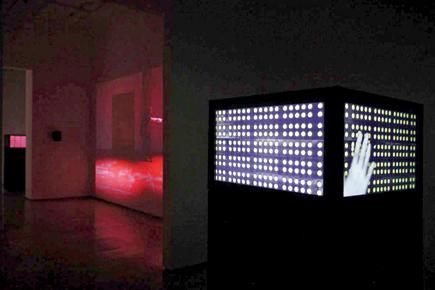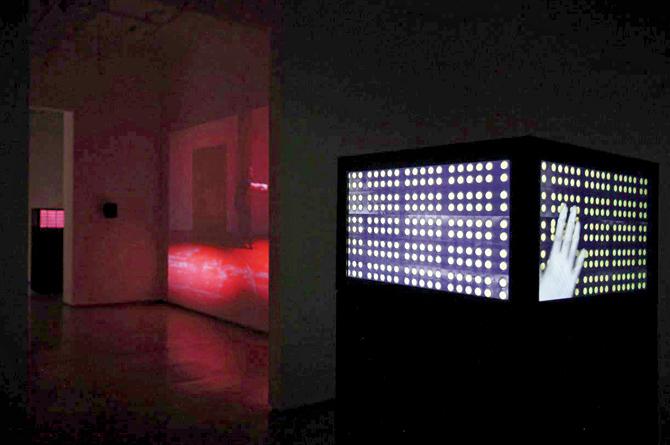What can video-art on a pharmaceutical company and drugs be about?

Red Blister (2014), a video-box in Remedies by audio-visual artist Surabhi Saraf
At Remedies, Surabhi Saraf’s new solo exhibition in the city, you hover around a box, the size of a modest refrigerator, on which a video strip goes around. Blister packs get filled with yellow pills in this video-box called Yellow Blister; there is another called Red Blister. Just as you think “cute”, a gloved hand emerges out of nowhere in the videos, and fixes gaps in the rows of tablets. It’s a matter of just seconds before empty spots become red and yellow dots.
ADVERTISEMENT

Red Blister (2014), a video-box in Remedies by audio-visual artist Surabhi Saraf
For San Francisco-based Saraf, Remedies is a new look at childhood memories of a pharmaceutical factory that her family owns in Indore. “I used to walk through its long corridors and look at machines that pressed raw powder into tablets. Pharmaceutical factories, especially family-owned ones, are designed differently. They are more intimate; they are not 100 people in a warehouse,” says Saraf, who moved to the USA in 2012. On her frequent visits home in the last few years, she had to wait for the “right kind of mindset” to see the difference between ‘labour’ (“distressed and lacking in cognitive abilities”) and ‘work’ (“improvising the situation and rewarding”).
 Surabhi Saraf
Surabhi Saraf
Knowing the difference, the 32-year-old audio-visual artist explores the intimate relation between humans and machines in Remedies, which has two film projections and three video-boxes (you wish there were a couple more) at Colaba’s Galerie Mirchandani + Steinruecke. Commenting on Yellow Blister, Saraf says, “They have been working with machines for so long that they know when the machines are prone to make a mistake. They understand and adapt to how a machine behaves.”
The videos show performance artistes choreographed to mimic a small factory line of people and the “art” behind medicine manufacture. In Tablet (10 min 17 sec), the performers have become one with the machines — granulators, rotaries, blenders. They move in accordance with the strong thumps in the audio — recordings of the percussive sounds characteristic to past-generation factory machines. Saraf, who graduated from Baroda’s MS University and then went on to acquire an MFA in Art and Technology from the School of the Art Institute of Chicago, says, “The audio is layered with tonal frequencies, which gives an aura. Machine sounds are colder; this is a warm environment.”
The mere mention of ‘pharmaceutical’ and ‘factory’ is not something the average viewer will associate with a “warm environment”. A Marxist critique on labour policies or an investigation of the lobbying of pharma companies or the detrimental effects of mass medicine consumption is what comes to mind. Think Fire in the Blood or Big Bucks, Big Pharma — documentaries made on the USA’s powerful pharmaceutical industry.
Or, Polish artist Joanna Rajkowska’s sculptures of guns made out of powdered painkillers mixed with resin as a comment on the misuse of scientific knowledge. Saraf says, “We have had a century of these immediate associations with modern drugs. I wanted to see it from a new perspective. I am interested in the politics of pharmaceutical manufacture but do not wish to express it that way. Medicines are also about healing.”
The philosophy behind pharma art can be to criticise or to support, and Saraf chooses the latter, at the risk of being accused of glossing over. But consider fabled English artist Damien Hirst’s Medicine Cabinets (2010) and his earlier room-sized installation, Pharmacy (1992). Art is capable of healing, was his syllogism. With its cool whites and neatly stacked medicine bottles, pharma art can be pop and positive.
Saraf’s performance art videos are imposing and engaging through the bold audios and the gesture-controlled environments they create. Furthermore, movement is medicine, says Saraf, who practises as a performance artist as well. “I have had injuries in the past five years, and have used different kinds of medication. But what has worked for me is movement,” she says.
 Subscribe today by clicking the link and stay updated with the latest news!" Click here!
Subscribe today by clicking the link and stay updated with the latest news!" Click here!








